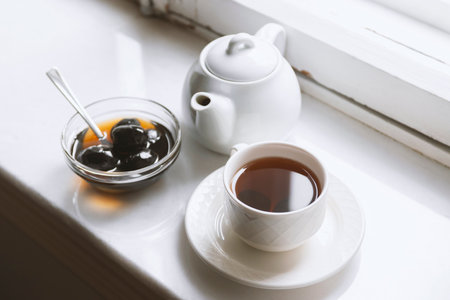Introduction: The British Tea Tradition
The humble cup of tea is more than just a beverage in the United Kingdom—it is a cornerstone of British culture, woven into the fabric of daily life. Whether it’s a quick brew during a hectic workday or a leisurely afternoon tea shared with friends and family, the ritual of making and enjoying tea provides comfort, connection, and a momentary escape from the hustle and bustle. The phrase “fancy a cuppa?” resonates across generations and social backgrounds, serving as both an invitation to pause and an act of hospitality. In this article, we will explore how the simple act of making tea—so deeply cherished in Britain—can be elevated by incorporating principles of Feng Shui, transforming your tea break into a harmonious and rejuvenating experience.
2. Choosing Your Tea: Flavours and Rituals
When it comes to the British cup of tea, selecting the right blend is as much an art as it is a daily ritual. In Britain, tea isn’t simply a beverage—it’s a cultural cornerstone, woven into the fabric of everyday life and breaks at work or home. Whether you prefer a classic brew or something more adventurous, your choice of tea sets the tone for both your pause and your space’s energy, echoing the principles of Feng Shui in harmony and personal well-being.
Popular British Teas: A Brief Overview
| Type of Tea | Flavour Profile | Best Time to Enjoy | Typical Ritual |
|---|---|---|---|
| English Breakfast | Strong, malty, robust | Morning or with a hearty breakfast | Brewed strong, served with milk and sometimes sugar |
| Earl Grey | Fragrant, citrusy (bergamot) | Afternoon or early evening | Brewed lightly; often taken black or with lemon slice |
| Darjeeling | Delicate, floral, slightly musky-sweet | Mid-morning or afternoon tea | Brewed lightly, usually without milk |
| Assam | Bold, brisk, malty | Early morning or after meals | Brewed strong; ideal with milk and sugar for a comforting cuppa |
| Herbal Infusions (e.g., Chamomile) | Mellow, soothing, floral or fruity notes | Evening or before bed for relaxation | Brewed gently; rarely taken with milk or sugar |
The Ritual: Brewing the Perfect Cuppa
The ritual of making tea in Britain is steeped in tradition. It starts with warming the teapot—a step believed to foster good energy flow in line with Feng Shui by respecting both ingredients and process. Loose leaf teas are favoured by purists for their full-bodied flavour and mindful preparation. Timing is crucial: most black teas are steeped for 3-5 minutes to unlock their full potential without bitterness.
Cultural Touchstones in Tea Preparation
- The Right Water: Always use freshly drawn cold water for boiling—stale water lacks oxygen and dulls flavours.
- Cup vs Mug: The debate is ongoing, but many say a china cup enhances subtle aromas while mugs offer comfort and warmth.
- Sugar and Milk: Some add sugar first (“milk-in-first” or “milk-in-last” is still hotly debated!), reflecting regional habits and personal taste.
- Mindful Moments: Use brewing time as a chance to pause, breathe, and set intentions—mirroring Feng Shui’s emphasis on creating positive energy flows.
The Intersection of Tradition and Well-being
Selecting your tea and performing its rituals is more than habit—it’s a way to bring awareness to your surroundings. By choosing blends that suit your mood and preparing them thoughtfully, you align yourself with both British custom and Feng Shui principles. This mindful approach transforms every break into an opportunity for balance, refreshment, and renewed focus.
![]()
3. Setting the Scene: Feng Shui Basics for Tea Breaks
When it comes to enjoying a classic British cup of tea, setting plays a surprisingly important role. This is where Feng Shui, the ancient Chinese practice of harmonising ones environment, becomes relevant—even in the heart of Britain. At its core, Feng Shui is about creating balance and promoting positive energy flow (or “chi”) within a space, principles that can be subtly woven into your daily tea rituals.
Feng Shui encourages attention to the placement of objects, colours, and natural elements to influence wellbeing. For instance, arranging your tea corner near a source of natural light not only brightens the mood but also boosts alertness—crucial for those mid-afternoon slumps. Incorporating greenery, such as a small potted plant or fresh flowers on your table, brings vitality and a sense of calm to your break.
Clutter is considered a major disruptor of good energy. A tidy tea station—whether it’s your kitchen counter or an office nook—makes preparing your brew a more mindful experience. Storage jars for your loose-leaf tea or biscuits, neatly arranged mugs, and a clean surface invite you to slow down and savour the moment. Even subtle changes like choosing calming hues for your tea set or napkins—think soft blues, greens or warm neutrals—can enhance relaxation according to Feng Shui colour theory.
Ultimately, adopting basic Feng Shui principles doesn’t mean overhauling your home with dragons and wind chimes. Instead, it’s about making thoughtful adjustments that support comfort and tranquillity during your cherished tea breaks. In doing so, you blend British tradition with holistic wellbeing, making every cuppa not just a drink but an act of self-care.
4. Arranging Your Space: Harmonising Your Tea Break
Creating a harmonious tea break environment goes beyond simply boiling the kettle; it’s about designing a space that enhances relaxation and sociability, in true British style. By integrating Feng Shui principles, you can transform your home or office into a haven for the perfect cuppa. Below are practical tips and a quick-reference table to help you set up your tea space tailored for British settings.
Choosing the Right Location
Ideally, select a spot with natural light—perhaps by a bay window or in a cosy nook away from busy walkways. A quiet corner minimises distractions, echoing both British sensibility and Feng Shui’s emphasis on tranquillity.
Elements of Balance: The Five Elements in Your Tea Area
Feng Shui focuses on balancing five elements: wood, fire, earth, metal, and water. In a British context, think of this as blending tradition (the classic teapot), comfort (a soft armchair), and function (a sturdy tray). Here’s how you might incorporate each element:
| Element | British Example | Purpose |
|---|---|---|
| Wood | Oak tea tray or table | Growth & vitality |
| Fire | Candle or warm-toned lamp | Warmth & energy |
| Earth | Ceramic mugs, stoneware teapot | Stability & nourishment |
| Metal | Spoon holder or tin biscuit box | Clarity & precision |
| Water | Kettle or fresh flowers in water | Flow & refreshment |
Clever Organisation for Everyday Ease
Avoid clutter by using baskets or drawers for teabags and biscuits. Keep only what you need at hand—this nods to both British practicality and Feng Shui’s preference for clear surfaces.
Sociable Seating Arrangements
If possible, arrange seating to encourage conversation—a small round table with two or three chairs invites company without crowding the space. Add a tartan cushion or wool throw for warmth and texture.
By thoughtfully arranging your tea space with these Feng Shui-inspired tips, you’ll find your daily break becomes more than just routine—it transforms into a ritual that refreshes both mind and spirit, true to the art of the British cup of tea.
5. Enhancing Mindfulness: The Tea Break as a Moment of Balance
In the fast-paced rhythm of British life, the humble tea break offers more than just a moment to sip on your favourite brew; it provides a unique opportunity to cultivate mindfulness and restore balance. By thoughtfully integrating Feng Shui principles into your tea routine, you can transform this everyday pause into a conscious act of relaxation and focus.
Designing Your Mindful Space
Begin by selecting a spot that feels comfortable and uncluttered. According to Feng Shui, a tidy environment encourages positive energy flow and helps clear mental fog. Position your chair near natural light if possible, as sunlight invigorates both mood and clarity. A simple coaster or tray can help define your personal tea zone, subtly signalling to yourself and others that this is your dedicated moment for pause.
The Ritual of Preparation
Take time in the preparation: listen to the kettle boil, inhale the aroma of loose-leaf tea or your favourite English Breakfast blend, and notice the steam rising from your cup. Engaging each sense grounds you in the present, making even a brief break restorative. Use this as an intentional reset—let go of morning stress or midday distractions with each mindful sip.
Balancing Energy Through Intention
Incorporate small touches that foster harmony. A potted plant or fresh flowers on your table add living energy (Sheng Qi) to your space, in keeping with both British fondness for gardens and Feng Shui wisdom. Placing your teacup on the right side of your workspace can symbolise welcoming new opportunities, while facing towards an open window or door encourages openness and perspective.
Cultivating Focus for the Rest of the Day
A consciously designed tea break not only soothes but also sharpens focus. By honouring this interlude—free from screens and urgent emails—you return to tasks with renewed clarity. The art lies not just in brewing the perfect cup but in crafting a mindful ritual, one that gently restores equilibrium amidst daily demands.
6. Conclusion: Blending Heritage with Harmony
The ritual of making a British cup of tea is more than just a daily habit—it is a cherished tradition that brings comfort, pause, and conviviality to our lives. By thoughtfully integrating Feng Shui principles into this quintessentially British practice, we can elevate our tea breaks from routine to restorative. Consider the placement of your teapot and cups, the flow of natural light in your sitting area, or the choice of calming colours and natural elements around you. These small but intentional adjustments can create a space that not only honours British heritage but also fosters a sense of balance and wellbeing. Whether you are sharing a pot with friends or enjoying a solitary brew, blending these two time-honoured approaches invites more harmony, presence, and delight into your everyday life. In this way, each cup becomes an opportunity—not just to refresh yourself, but to bring a little more peace and positive energy into your home.


